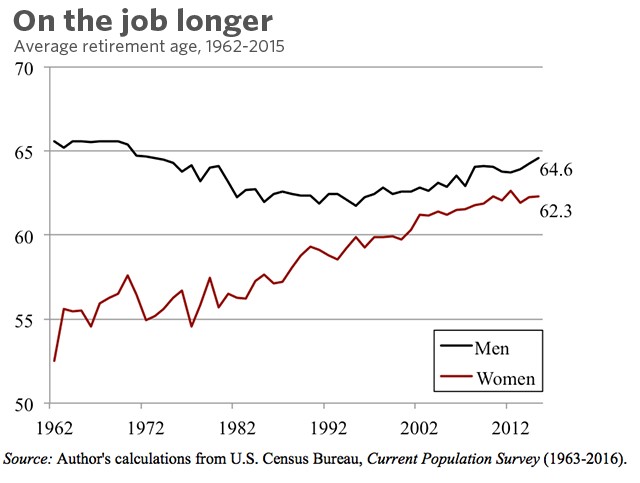The average retirement age for both men and women in America has steadily risen in the past 2+ decades (see chart below). The difference being that, while women’s average retirement age has trended upward for all 53 years covered in the chart, men’s retirement age had been declining until the 1980s, where it leveled off for some years before starting to increase a decade later. Most recently the average age of retirement is ~65 for men and ~62 for women.

According to the study (and logically) the trend in women’s average retirement age reflects both their increasing labor force participation over time and the factors that affect retirement behavior.
So what are these “factors” that helped sustain the uptrend in average retirement age for women and caused a reversal in trend for men? Here are several identified by the study authors:
- Social Security: Changes made work more attractive relative to retirement. The liberalization of the earnings test (i.e. Social Security benefits may be subject to an earnings test that reduces amount paid out if you receive benefits and continue to work) removed what many saw as an impediment to continued work. The delayed retirement credit, which increases benefits for each year that claiming is delayed between the Full Retirement Age and age 70, has also improved incentives to keep working.
- Decrease in Pension Plans: The shift from defined benefit to 401(k) plans eliminated built-in incentives to retire. Studies show that workers covered by 401(k) plans retire a year or two later on average than similarly situated workers covered by a defined benefit plan.
- Education: People with more education work longer. Over the last thirty years, education levels have increased significantly.
- Improved health and longevity: Life expectancy has increased, and much of the evidence suggests that people are healthier as well. The correlation between health and labor force activity is very strong.
- Less physically demanding jobs: With the shift away from manufacturing, jobs now involve more knowledge-based activities, which put less strain on older bodies.
- Joint decision-making: More women are working, wives on average are three years younger than their husbands, and husbands and wives generally like to coordinate their retirement. If wives wait to retire until age 62 to qualify for Social Security, that pattern would push husbands’ retirement age towards 65.
- Decline of retiree health insurance: Combine the decline of employer-provided retiree health insurance with the rapid rise in health care costs, and workers have a strong incentive to keep working and maintain their employer’s health coverage until they qualify for Medicare at 65.
- Non-pecuniary factors: Older workers tend to be among the more educated, the healthiest, and the wealthiest. Their wages are lower than those earned by their younger counterparts and lower than their own past earnings. This pattern suggests that money may not be the only motivator.
Source: http://www.marketwatch.com/story/why-the-average-retirement-age-is-rising-2017-10-09
